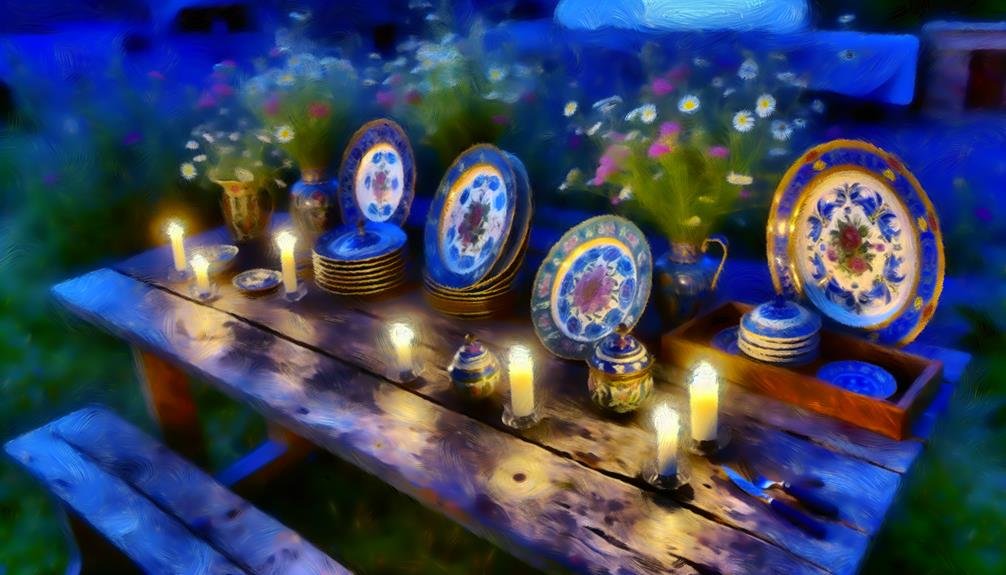Antique plates boast unique aesthetic appeal, showcasing elaborate designs and craftsmanship that evoke nostalgia. Their historical significance provides understanding into artistry and societal trends of the past, making them precious collectibles. Additionally, they can appreciate in value, especially rare pieces in pristine condition. Nevertheless, maintaining these fragile items can pose challenges; they require careful storage and specialized cleaning methods that may damage decorations. Furthermore, many are not food-safe due to hazardous glazes. Despite these drawbacks, understanding both the benefits and obstacles can deepen your appreciation for these pieces. Exploring further will uncover additional knowledge into their value.
Main Points
- Antique plates showcase unique craftsmanship and historical artistry, adding aesthetic appeal to collections and home decor.
- Their historical significance provides insights into cultural and economic contexts of different eras, enhancing their value.
- Antique plates can appreciate in value over time, making them potential financial investments if properly maintained.
- Maintenance challenges arise due to fragility and specific cleaning requirements, which can complicate ownership.
- Practicality issues include potential non-food safety, limited matching pieces, and the risk of damage during use or display.
Unique Aesthetic Appeal
Antique plates possess a unique aesthetic appeal that distinguishes them from contemporary tableware. Their complex designs, often hand-painted or featuring elaborate motifs, reflect the craftsmanship of bygone eras, conveying a sense of artistry that is increasingly rare in modern production. Each plate tells a story, showcasing the cultural influences and artistic trends of its time, which adds depth and character to any collection or dining experience.
Additionally, much like the stunning flowers of magnolia trees that beautify environments with their beauty, antique plates can create focal points in home decor. The colors and patterns found on antique plates often evoke nostalgia, creating an atmosphere that is both warm and inviting. The variations in shape and texture among these pieces further increase their visual interest, allowing them to serve not only as functional items but also as decorative art. When displayed, antique plates can transform a space, serving as conversation starters and focal points that captivate guests.
Moreover, the unique patina and imperfections found in antique plates contribute to their charm. These characteristics are often viewed as marks of authenticity, setting them apart from mass-produced alternatives.
In the end, the aesthetic allure of antique plates lies in their ability to merge functionality with artistic expression, making them a valued addition to any home.
Historical Significance
The historical significance of antique plates extends beyond their aesthetic value, offering a tangible connection to the past. These artifacts serve as windows into the cultural, social, and economic contexts of their time. Collectors and enthusiasts often appreciate how antique plates encapsulate specific historical narratives and craftsmanship techniques, similar to the cultural reflection seen in commonwealth states.
Here are four key aspects of their historical significance:
- Cultural Reflection: Antique plates often showcase the artistry and design trends of their era, reflecting the cultural values and societal norms of the time.
- Technological Understanding: The materials and techniques used in creating these plates provide understanding into the technological advancements in pottery and ceramics throughout history.
- Trade and Economy: Many antique plates reveal trade routes and economic exchanges, illustrating how goods were transported and valued across different regions.
- Social Status: The types of plates used by different social classes can indicate wealth and status, serving as a demonstration to the lifestyles of various historical groups.
Investment Value
Investing in antique plates offers collectors not only the joy of ownership but also the potential for financial appreciation. As the market for antiques continues to grow, insightful buyers often seek unique pieces that can serve as both decorative art and viable investments. The value of antique plates can fluctuate based on various factors including rarity, condition, provenance, and market demand.
To better understand the investment potential, consider the following table that outlines key aspects of antique plate investments:
| Factor | Description | Impact on Value |
|---|---|---|
| Rarity | Limited production or unique designs | High value |
| Condition | Pristine condition vs. wear and tear | Direct correlation |
| Provenance | History of ownership and documentation | Increases desirability |
Collecting antique plates can yield notable returns, especially if one invests in pieces from reputable manufacturers or those with historical importance. Nevertheless, it is essential for collectors to conduct thorough research and remain informed about market trends to maximize their investment. In the end, the blend of aesthetic appeal and financial potential makes antique plates an intriguing addition to any collection.
Maintenance Challenges
Maintaining antique plates presents a unique set of challenges that collectors must maneuver to preserve their investment. The delicate nature of these items requires careful handling and specific cleaning methods to prevent damage, similar to how exceptional cushioning and comfort play a significant role in protecting your feet during physical activities.
Here are some key challenges collectors often face:
- Fragility: Many antique plates are made from materials that can chip or crack easily, necessitating cautious storage and display.
- Cleaning Restrictions: Traditional cleaning methods, such as scrubbing or using harsh chemicals, can harm the decorative finishes or glazes. Instead, gentle cleaning with mild soap and soft cloths is advisable.
- Environmental Factors: Humidity and temperature fluctuations can lead to deterioration. Storing plates in a controlled environment is essential to prevent warping or discoloration.
- Repair Difficulties: If an antique plate sustains damage, finding skilled artisans for restoration can be challenging and expensive, often risking the plate's value if not done correctly.
These maintenance challenges underscore the importance of proper care and informed decision-making for antique plate collectors, ensuring that their cherished items remain in pristine condition for years to come.
Practicality Issues
Antique plates often present practicality issues that can deter potential collectors from fully engaging with these exquisite items. One of the primary concerns is their fragility; many antique plates are made from delicate materials such as porcelain or bone china, making them susceptible to chips and cracks. This fundamental fragility necessitates careful handling and storage, which may not align with the lifestyle of many contemporary collectors.
Moreover, the question of usability arises. While some collectors may wish to display these plates, others might be tempted to use them for dining. Yet, many antique plates are not food-safe due to lead glazes or other hazardous materials used in their production. This limitation can notably reduce their practicality, as collectors must choose between display and potential health risks.
Additionally, antique plates often require specialized cleaning methods, which can be time-consuming and may discourage regular use.
Finally, the limited availability of matching pieces can complicate the creation of cohesive table settings, further hindering their practicality.
To conclude, these practicality issues demand careful consideration from anyone contemplating the addition of antique plates to their collection.
Common Questions
Where Can I Find Authentic Antique Plates for Purchase?
To find authentic antique plates for purchase, consider reputable auction houses, antique shops, and online marketplaces specializing in vintage items. Additionally, attending antique fairs and estate sales can yield unique finds from knowledgeable vendors.
How Can I Identify the Age of an Antique Plate?
To identify the age of an antique plate, examine its markings, materials, and craftsmanship. Research specific patterns or manufacturers, and consult reference books or experts in antique ceramics for accurate dating and historical context.
Are There Specific Brands or Makers Known for Their Antique Plates?
Yes, several brands and makers are renowned for their antique plates, including Meissen, Royal Worcester, and Limoges. Each brand has distinct characteristics, contributing to their collectible value and historical significance in the domain of ceramics.
What Are Some Common Myths About Collecting Antique Plates?
Common myths surrounding antique plate collecting include the belief that all antique plates are precious, that conditions do not affect value, and that modern replicas are indistinguishable from genuine antiques, which can mislead unsuspecting collectors.
Can Antique Plates Be Used for Everyday Dining?
Antique plates can be used for everyday dining, but caution is advised. Their fragility and potential for chemical leaching, particularly in older pieces, necessitate careful consideration of their suitability for regular use in meal service.
Conclusion
In conclusion, antique plates offer a unique aesthetic appeal, historical significance, and potential investment value, making them desirable for collectors and enthusiasts. Nevertheless, challenges related to maintenance and practicality must be considered. The delicate nature of these items may limit their everyday use, while the requirement for specialized care can deter some individuals from pursuing them. Ultimately, the decision to acquire antique plates should weigh both the advantages and disadvantages intrinsic to these historical artifacts.

